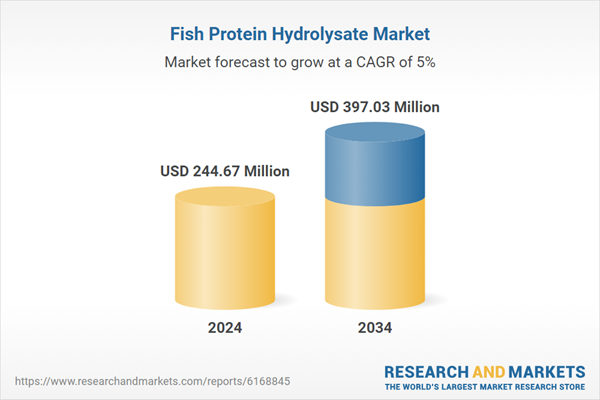Increasing demand for clean-label and sustainable protein sources in livestock and pet nutrition continues to support the market’s upward trajectory. Fish protein hydrolysates, derived as by-products from fish processing, are gaining prominence as environmentally responsible alternatives to conventional feed ingredients. This growth is being driven by the shift away from traditional proteins like soybean meal and synthetic additives. With growing concerns surrounding resource efficiency and environmental impact, both manufacturers and consumers are prioritizing solutions that support long-term sustainability goals in feed production. This has led to an uptick in the inclusion of hydrolysates in feed for poultry, aquaculture, and companion animals. Nutritional advantages, including better digestibility and high concentrations of peptides, amino acids, and other bioactive compounds, are further influencing adoption. As farmers and pet owners become more educated on feed efficiency and animal health outcomes, fish protein hydrolysates are increasingly viewed as essential functional ingredients across modern feed formulations.
The enzymatic hydrolysis segment reached USD 205.02 million in 2024 and is expected to grow at a CAGR of 5.1% through 2034. Enzymatic processing methods are being widely adopted for their ability to break down proteins without compromising nutritional value. This technique yields highly digestible, bioactive peptides suitable for improving immune response and gut health in animals. The consistency and premium quality of enzymatic hydrolysates make them especially attractive in high-performance animal diets and specialty pet foods, giving this segment a competitive edge over traditional hydrolysis techniques.
In terms of application, the animal feed segment held 76.1% share and is forecasted to grow at a 4.7% CAGR from 2025 to 2034. These hydrolysates are extensively used in poultry, swine, and aquaculture industries, owing to their high amino acid availability, digestibility, and efficiency in supporting weight gain and overall vitality in animals. Their inclusion enhances feed-to-growth ratios and provides sustainable protein options, aligning with the rising demand for functional and eco-conscious animal nutrition strategies across commercial farming sectors.
North America Fish Protein Hydrolysate Market Size for Animal Feed & Pet Food Application held 26% share in 2024. The region continues to gain traction due to consumer interest in sustainable protein sourcing and a broader shift toward functional ingredients in animal diets. Regulatory support for responsible fishing practices and circular economy initiatives around fish by-products has also contributed to market expansion. As nutritional science advances and environmental concerns grow, North America is expected to remain a key regional player, driving demand for high-quality fish-derived proteins in feed production.
Leading companies active in the Global Fish Protein Hydrolysate Market Size for Animal Feed & Pet Food Application Market include Bio-Marine Ingredients Ireland Ltd, Nutrifish, Rossyew, SAMPI, Scanbio Marine Group, Sociedad Pesquera, Alaska Protein Recovery, Diana Aqua (Symrise AG), Triplenine Group A/S, SOPROPECHE, Omega Protein, Janatha Fish Meal & Oil Products, Copalis Sea Solutions, TC Union Agrotech, and Hofseth Biocare ASA. To solidify their market presence, key players in the Fish Protein Hydrolysate Market Size for Animal Feed & Pet Food Application are prioritizing innovation, sustainability, and capacity expansion. Companies are investing in advanced enzymatic hydrolysis technologies to improve product quality, bioavailability, and shelf stability, particularly for high-end pet food and aquaculture applications. Many are also strengthening supply chains by securing access to sustainable fish raw materials and integrating vertically into managing production costs. Strategic partnerships with feed manufacturers, aquaculture farms, and pet food brands are facilitating co-development of custom formulations. Moreover, firms are emphasizing circular economy models by utilizing fish processing by-products, reinforcing their environmental responsibility narratives.
Comprehensive Market Analysis and Forecast
- Industry trends, key growth drivers, challenges, future opportunities, and regulatory landscape
- Competitive landscape with Porter’s Five Forces and PESTEL analysis
- Market size, segmentation, and regional forecasts
- In-depth company profiles, business strategies, financial insights, and SWOT analysis
This product will be delivered within 2-4 business days.
Table of Contents
Companies Mentioned
The companies profiled in this Fish Protein Hydrolysate market report include:- SOPROPECHE
- Diana Aqua (Symrise AG)
- Copalis Sea Solutions
- Scanbio Marine Group
- Bio-Marine Ingredients Ireland Ltd
- Hofseth Biocare ASA
- Janatha Fish Meal & Oil Products
- SAMPI
- Nutrifish
- TC Union Agrotech
- Alaska Protein Recovery
- Rossyew
- Sociedad Pesquera
- Triplenine Group A/S
- Omega Protein
Table Information
| Report Attribute | Details |
|---|---|
| No. of Pages | 192 |
| Published | September 2025 |
| Forecast Period | 2024 - 2034 |
| Estimated Market Value ( USD | $ 244.67 Million |
| Forecasted Market Value ( USD | $ 397.03 Million |
| Compound Annual Growth Rate | 5.0% |
| Regions Covered | Global |
| No. of Companies Mentioned | 16 |









